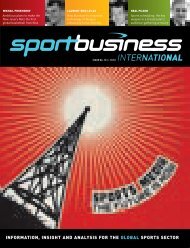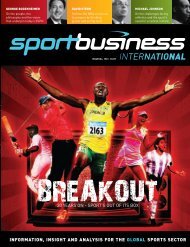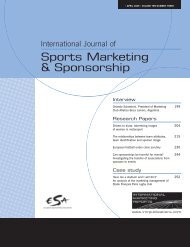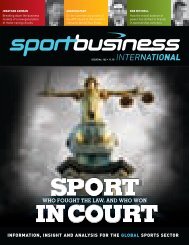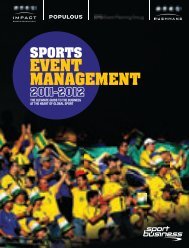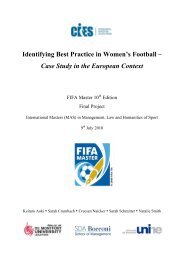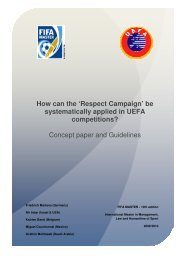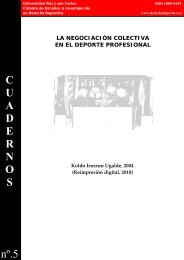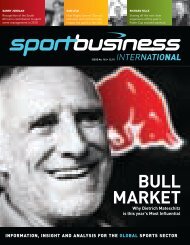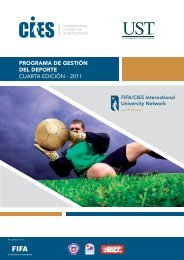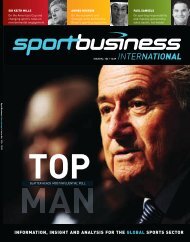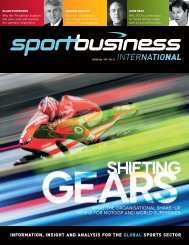4 - FIFA/CIES International University Network
4 - FIFA/CIES International University Network
4 - FIFA/CIES International University Network
You also want an ePaper? Increase the reach of your titles
YUMPU automatically turns print PDFs into web optimized ePapers that Google loves.
promoting the Budweiser brand but there are<br />
certain markets around the world where we<br />
wanted to activate on other AB InBev brands.<br />
These included Brahma in Brazil (the brand<br />
already sponsors the Brazilian national teams),<br />
Jupiler in Holland and Harbin in China.<br />
“We are not like Coca-Cola which has one brand<br />
across all territories. The creation of AB InBev<br />
opened the floodgates to a number of brands and<br />
this became the cornerstone of our strategy. To<br />
make the sponsorship worthwhile we simply had<br />
to involve multiple brands and, naturally, <strong>FIFA</strong> was<br />
initially very protective because it was concerned<br />
about the possibility of clutter around the beer<br />
category,” Van der Noll said.<br />
With the agreement of <strong>FIFA</strong> in place, AB InBev<br />
developed a two-phase approach. In-country<br />
activations for key individual brands made full<br />
use of the World Cup assets while Budweiser,<br />
which was promoted across some 80 territories<br />
worldwide, was supported by a global digital<br />
overlay built around the concept of Budweiser<br />
United, a social network-based programme<br />
drawing the world together around its love of<br />
football, reality shows and, of course, beer.<br />
Here was an example of how partnerships<br />
between brands and sports properties have<br />
delivered over the years and how the apparently<br />
limitless potential of the digital universe is<br />
encouraging creativity.<br />
The Bud House was an online reality show<br />
Eelco van der Noll<br />
Global Director, Sports &<br />
Entertainment, AB InBev<br />
A marketing graduate from Rotterdam’s<br />
Institute for Business Administration &<br />
Economics, van der Noll joined Japanese<br />
multinational Canon in 1990 where he<br />
developed several integrated marketing<br />
programmes for the company.<br />
He joined global payments solutions<br />
company MasterCard in 1995, where<br />
as Vice-President he negotiated and<br />
contributed to multi-million dollar<br />
partnership agreements with sports bodies<br />
including <strong>FIFA</strong>, UEFA, Jordan F1 and<br />
Manchester United. He also developed<br />
programmes to promote the <strong>FIFA</strong> World<br />
Cup and Pelé-themed payment cards.<br />
<strong>FIFA</strong> soon came calling, and van der Noll<br />
assumed the position of Head of Marketing,<br />
overseeing the development and the<br />
commercialisation of football worldwide.<br />
In his four years with <strong>FIFA</strong> he generated<br />
incremental revenue of $80 million through<br />
the sale of sponsorship packages.<br />
After a brief spell at Momentum<br />
Worldwide, van der Noll joined Anheuser<br />
Busch InNev in June 2009.<br />
along the lines of Big Brother, but with a<br />
difference. The inhabitants of the house, in Cape<br />
Town, represented the 32 nations which qualified<br />
for the World Cup finals. As the teams were<br />
eliminated, so was their Bud House counterpart.<br />
Available on and linked to the leading social<br />
media platforms, it quickly created a global<br />
community united by its engagement in and<br />
willingness to talk about the project.<br />
This online offering was complemented by a<br />
global Man of the Match vote, while the Bud Cup<br />
was organised to bring teams of consumers to<br />
South Africa for their own knockout competition.<br />
“This was a truly global programme based<br />
around a beer to unify soccer fans, and the huge<br />
digital platform we created was certainly one of<br />
the highlights,” says Van der Noll.<br />
The programme delivered results on a range<br />
of measures, including ensuring that Budweiser<br />
was the top-selling drink - soft drinks and bottled<br />
water included - at World Cup stadiums.<br />
In addition, Budweiser’s Facebook fanbase<br />
added one million ‘likes’ during the five weeks<br />
of the tournament, while over 2.7 million fans<br />
showed their colours using the brand’s ‘Paint Your<br />
Face’ application on Facebook.<br />
Bud House attracted more than seven million<br />
views on syndicated channels while more than 1.5<br />
million fans voted for their Bud Man of the Match<br />
after each of the 64 games.<br />
In a press release issued along with the<br />
SportBusiness <strong>International</strong> • No.160 • 09.10 31



